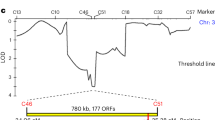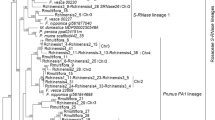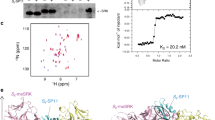Abstract
Higher plants produce seed through pollination, using specific interactions between pollen and pistil. Self-incompatibility is an important mechanism used in many species to prevent inbreeding; it is controlled by a multi-allelic S locus1,2. ‘Self’ (incompatible) pollen is discriminated from ‘non-self’ (compatible) pollen by interaction of pollen and pistil S locus components, and is subsequently inhibited. In Papaver rhoeas, the pistil S locus product is a small protein that interacts with incompatible pollen, triggering a Ca2+-dependent signalling network, resulting in pollen inhibition and programmed cell death3,4,5,6,7. Here we have cloned three alleles of a highly polymorphic pollen-expressed gene, PrpS (Papaver rhoeas pollen S), from Papaver and provide evidence that this encodes the pollen S locus determinant. PrpS is a single-copy gene linked to the pistil S gene (currently called S, but referred to hereafter as PrsS for Papaver rhoeas stigma S determinant). Sequence analysis indicates that PrsS and PrpS are equally ancient and probably co-evolved. PrpS encodes a novel ∼20-kDa protein. Consistent with predictions that it is a transmembrane protein, PrpS is associated with the plasma membrane. We show that a predicted extracellular loop segment of PrpS interacts with PrsS and, using PrpS antisense oligonucleotides, we demonstrate that PrpS is involved in S-specific inhibition of incompatible pollen. Identification of PrpS represents a major advance in our understanding of the Papaver self-incompatibility system. As a novel cell–cell recognition determinant it contributes to the available information concerning the origins and evolution of cell–cell recognition systems involved in discrimination between self and non-self, which also include histocompatibility systems in primitive chordates and vertebrates.
This is a preview of subscription content, access via your institution
Access options
Subscribe to this journal
Receive 51 print issues and online access
$199.00 per year
only $3.90 per issue
Buy this article
- Purchase on Springer Link
- Instant access to full article PDF
Prices may be subject to local taxes which are calculated during checkout



Similar content being viewed by others
Change history
02 December 2015
Nature 459, 992–995 (2009); doi: 10.1038/nature08027 Recently, it has come to our attention that in the left panel of Fig. 2b of this Letter, the lanes labelled S2S4 and S6S17 were duplicated. We have reviewed the original data. It seems likely that a duplicated part of the blot was placed over laneS6S17 to aid alignment of molecular mass markers and inadvertently left there.
References
Takayama, S. & Isogai, A. Self-incompatibility in plants. Annu. Rev. Plant Biol. 56, 467–489 (2005)
Franklin-Tong, V. E. (ed.) Self-Incompatibility in Flowering Plants: Evolution, Diversity, and Mechanisms (Springer, 2008)
de Graaf, B. H. J. et al. Self-incompatibility in Papaver targets soluble inorganic pyrophosphatases in pollen. Nature 444, 490–493 (2006)
Franklin-Tong, V. E., Ride, J. P., Read, N. D., Trewavas, A. J. & Franklin, F. C. H. The self-incompatibility response in Papaver rhoeas is mediated by cytosolic-free calcium. Plant J. 4, 163–177 (1993)
Snowman, B. N., Kovar, D. R., Shevchenko, G., Franklin-Tong, V. E. & Staiger, C. J. Signal-mediated depolymerization of actin in pollen during the self-incompatibility response. Plant Cell 14, 2613–2626 (2002)
Thomas, S. G. & Franklin-Tong, V. E. Self-incompatibility triggers programmed cell death in Papaver pollen. Nature 429, 305–309 (2004)
Bosch, M. & Franklin-Tong, V. E. Temporal and spatial activation of caspase-like enzymes induced by self-incompatibility in Papaver pollen. Proc. Natl Acad. Sci. USA 104, 18327–18332 (2007)
Foote, H. C. C. et al. Cloning and expression of a distinctive class of self-incompatibility (S) gene from Papaver rhoeas L. Proc. Natl Acad. Sci. USA 91, 2265–2269 (1994)
Kurup, S. et al. Identification and cloning of related self-incompatibility S-genes in Papaver rhoeas and Papaver nudicaule . Sex. Plant Reprod. 11, 192–198 (1998)
Walker, E. A. et al. Molecular analysis of two functional homologues of the S 3 allele of the Papaver rhoeas self-incompatibility gene isolated from different populations. Plant Mol. Biol. 30, 983–994 (1996)
Thomas, S. G., Huang, S., Li, S., Staiger, C. J. & Franklin-Tong, V. E. Actin depolymerization is sufficient to induce programmed cell death in self-incompatible pollen. J. Cell Biol. 174, 221–229 (2006)
Hearn, M. J., Franklin, F. C. H. & Ride, J. P. Identification of a membrane glycoprotein in pollen of Papaver rhoeas which binds stigmatic self-incompatibility (S-) proteins. Plant J. 9, 467–475 (1996)
Ioerger, T. R., Clark, A. G. & Kao, T.-H. Polymorphism at the self-incompatibility locus in Solanaceae predates speciation. Proc. Natl Acad. Sci. USA 87, 9732–9735 (1990)
Kohn, J. R. in Self-Incompatibility in Flowering Plants: Evolution, Diversity, and Mechanisms (ed. Franklin-Tong, V. E.) 103–121 (Springer, 2008)
Charlesworth, D. Multi-allelic self-incompatibility polymorphisms in plants. Bioessays 17, 31–38 (1995)
Newbigin, E., Paape, T. & Kohn, J. R. RNase-based self-incompatibility: puzzled by pollen S. Plant Cell 20, 2286–2292 (2008)
von Heijne, G. & Gavel, Y. Topogenic signals in integral membrane proteins. Eur. J. Biochem. 174, 671–678 (1988)
Biris, N. et al. Mapping the binding domains of the αIIb subunit. Eur. J. Biochem. 270, 3760–3767 (2003)
Moutinho, A. et al. Antisense perturbation of protein function in living pollen tubes. Sex. Plant Reprod. 14, 101–104 (2001)
McClure, B. & Franklin-Tong, V. Gametophytic self-incompatibility: understanding the cellular mechanisms involved in “self” pollen tube inhibition. Planta 224, 233–245 (2006)
Sijacic, P. et al. Identification of the pollen determinant of S-RNase-mediated self-incompatibility. Nature 429, 302–305 (2004)
Qiao, H. et al. The F-box protein AhSLF-S2 controls the pollen function of S-RNase-based self-incompatibility. Plant Cell 16, 2307–2322 (2004)
Stein, J. C., Howlett, B., Boyes, D. C., Nasrallah, M. E. & Nasrallah, J. B. Molecular cloning of a putative receptor protein kinase gene encoded at the self-incompatibility locus of Brassica oleracea . Proc. Natl Acad. Sci. USA 88, 8816–8820 (1991)
Dangl, J. L. & Jones, J. D. G. Plant pathogens and integrated defence responses to infection. Nature 411, 826–833 (2001)
Burnet, F. M. “Self-recognition” in colonial marine forms and flowering plants in relation to the evolution of immunity. Nature 232, 230–235 (1971)
De Tomaso, A. W. et al. Isolation and characterization of a protochordate histocompatibility locus. Nature 438, 454–459 (2005)
Scofield, V. L., Schlumpberger, J. M., West, L. A. & Weissman, I. L. Protochordate allorecognition is controlled by a MHC-like gene system. Nature 295, 499–502 (1982)
Worley, K. C., Wiese, B. A. & Smith, R. F. BEAUTY: an enhanced BLAST-based search tool that integrates multiple biological information resources into sequence similarity search results. Genome Res. 5, 173–184 (1995)
Rozas, J., Sanchez-DelBarrio, J. C., Messeguer, X., Rozas, R. & Dna, S. P. DNA polymorphism analyses by the coalescent and other methods. Bioinformatics 19, 2496–2497 (2003)
Krogh, A., Larsson, B., von Heijne, G. & Sonnhammer, E. L. Predicting transmembrane protein topology with a hidden Markov model: application to complete genomes. J. Mol. Biol. 305, 567–580 (2001)
Altschul, S. F., Gish, W., Miller, W., Myers, E. W. & Lipman, D. J. Basic local alignment search tool. J. Mol. Biol. 215, 403–410 (1990)
Krogh, A., Larsson, B., von Heijne, G. & Sonnhammer, E. L. Predicting transmembrane protein topology with a hidden Markov model: application to complete genomes. J. Mol. Biol. 305, 567–580 (2001)
Moller, S., Croning, M. D. R. & Apweiler, R. Evaluation of methods for the prediction of membrane spanning regions. Bioinformatics 17, 646–653 (2001)
Fisher, R. A. Statistical Methods and Scientific Inference (Hafner, 1956)
Bradford, M. M. A dye binding assay for protein. Anal. Biochem. 72, 248–254 (1976)
Snowman, B. N., Kovar, D. R., Shevchenko, G., Franklin-Tong, V. E. & Staiger, C. J. Signal-mediated depolymerization of actin in pollen during the self-incompatibility response. Plant Cell 14, 2613–2626 (2002)
Poulter, N. S., Vatovec, S. & Franklin-Tong, V. E. Microtubules are a target for self-incompatibility signaling in Papaver pollen. Plant Physiol. 146, 1358–1367 (2008)
Franklin-Tong, V. E., Lawrence, M. J. & Franklin, F. C. H. Self-incompatibility in Papaver rhoeas. 1. Characterization of the stigmatic component. Heredity 61, 286 (1988)
Foote, H. C. C. et al. Cloning and expression of a distinctive class of self-incompatibility (S) gene from Papaver rhoeas L. Proc. Natl Acad. Sci. USA 91, 2265–2269 (1994)
Geitmann, A., Snowman, B. N., Emons, A. M. C. & Franklin-Tong, V. E. Alterations in the actin cytoskeleton of pollen tubes are induced by the self-incompatibility reaction in Papaver rhoeas . Plant Cell 12, 1239–1251 (2000)
Jordan, N. D., Franklin, F. C. H. & Franklin-Tong, V. E. Evidence for DNA fragmentation triggered in the self-incompatibility response in pollen of Papaver rhoeas . Plant J. 23, 471–479 (2000)
Thomas, S. G. & Franklin-Tong, V. E. Self-incompatibility triggers programmed cell death in Papaver pollen. Nature 429, 305–309 (2004)
Bailey, N. T. J. Statistical Methods in Biology (The English Universities Press, 1959)
Acknowledgements
We thank S. Chen-Ying for contributing preliminary data and horticultural staff for growing and collecting plant material. We also thank J. Kohn for help and advice on sequence analysis, and A. Lovering and T. Hakoshima for advice regarding structural predictions. We wish to acknowledge the long-term contribution from M. Lawrence, who initiated studies on Papaver self-incompatibility. Work in the laboratories of F.C.H.F. and V.E.F.-T. is funded by the Biotechnology and Biological Sciences Research Council (BBSRC); this work was supported by grant BB/C501325/1.
Author Contributions M.J.W., B.H.J.d.G. and N.H. contributed equally to this work. F.C.H.F. and V.E.F.-T. are joint senior authors.
Author information
Authors and Affiliations
Corresponding author
Supplementary information
Supplementary Information
This file contains Supplementary Figures 1-4 with extended Legends and Supplementary Tables 1-2. (PDF 1180 kb)
Rights and permissions
About this article
Cite this article
Wheeler, M., de Graaf, B., Hadjiosif, N. et al. Identification of the pollen self-incompatibility determinant in Papaver rhoeas. Nature 459, 992–995 (2009). https://doi.org/10.1038/nature08027
Received:
Accepted:
Published:
Issue Date:
DOI: https://doi.org/10.1038/nature08027
This article is cited by
-
Genetics Behind Sexual Incompatibility in Plants: How Much We Know and What More to Uncover?
Journal of Plant Growth Regulation (2023)
-
A pair of non-Mendelian genes at the Ga2 locus confer unilateral cross-incompatibility in maize
Nature Communications (2022)
-
Incompatible pollen abortion and late-acting self-incompatibility in Schima superba
Scientific Reports (2022)
-
Aminooxyacetic acid (АОА), inhibitor of 1-aminocyclopropane-1-carboxilic acid (AСС) synthesis, suppresses self-incompatibility-induced programmed cell death in self-incompatible Petunia hybrida L. pollen tubes
Protoplasma (2020)
-
fagin: synteny-based phylostratigraphy and finer classification of young genes
BMC Bioinformatics (2019)
Comments
By submitting a comment you agree to abide by our Terms and Community Guidelines. If you find something abusive or that does not comply with our terms or guidelines please flag it as inappropriate.



